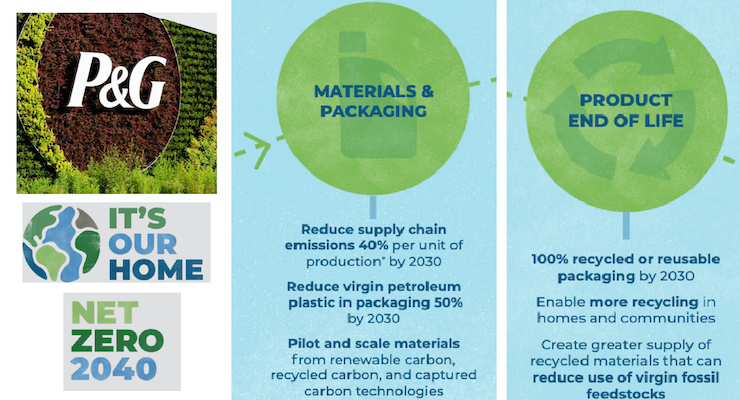09.15.21
Procter & Gamble has announced a comprehensive plan to accelerate action related to climate change.
The company has released its new goals in the comprehensive report, Climate Change Action Plan, that says, "It's Our Home - Net Zero 2040."
P&G says it will achieve net zero greenhouse gas emissions across its operations and supply chain, from raw material to retailer, by 2040.
David S. Taylor, chairman, P&G president and chief executive officer, says, “We are fully committed to use P&G’s innovation and ingenuity to unlock new solutions to address climate change. The task ahead of us is urgent, difficult and much bigger than any single company or country. P&G is tackling these challenges head-on by reducing our footprint and leveraging our scale to foster unprecedented collaboration across our value chain.”
Virginie Helias, P&G chief sustainability officer, adds, “While no one has all of the answers on how to bring a net zero future into focus, we will not let uncertainty hold us back. To achieve these goals, we will leverage existing solutions and seek transformative new ones that are not available in the marketplace today. This will require partnership across the private, nonprofit, and public sectors and involve every aspect of our business, from the very beginning of our products’ lifecycle to the very end.”
Packaging Goals
P&G's Materials & Packaging goals, as shown above, include decarbonizing its supply chain.Emissions "from raw material to retailer" are about ten times that of its operations—and its goal is to reduce emissions by 40% 'per unit of production' by 2030.
The company is also partnering to to increase transportation efficiency of outbound finished products 50% by 2030.
P&G will reduce the use of virgin petroleum plastic in packaging by 50% by 2030. The company will also pilot and scale materials from renewable carbon, recycled carbon, and captured carbon technologies.
P&G's new Product Supply Innovation Center in Kronberg, Germany is a hub for a network of local suppliers, tech companies, and top universities, developing solutions that are global and scalable to help decarbonize its supply chain.
While working toward advancing low-carbon technologies, materials, and packaging, by 2040, P&G is partnering to advance innovation in materials derived from renewable, bio-based, and recycled carbon across its brands. This includes Head & Shoulders and Pantene.
There are also plans to explore ingredients made from captured CO2.
Reduce Emissions & Accelerate Renewable Electricity
P&G’s top priority is to significantly reduce greenhouse gas emissions quickly as possible, by:- Reducing emissions across its operations. From 2010 to 2020 P&G has reduced absolute emissions across its global operations 52% through energy efficiency and renewable electricity. It is also advancing natural climate solutions to balance any remaining emissions from its operations that cannot be eliminated by 2030. These include new projects that help protect and restore forests and other ecosystems.
- Accelerating renewable electricity. P&G is nearing its 2030 goal of purchasing 100% renewable electricity by already purchasing 97% globally. In 2021, the United States Environmental Protection Agency recognized P&G as #5 on its National Top 100 list of green power users and #2 on its Top 30 list for on-site renewable power generation nationwide.
Leveraging Thermal Energy
P&G’s teams are working hard to develop the next generation of low-carbon technologies and materials. Its efforts include leveraging renewable thermal energy.P&G uses geothermal, solar, and renewable steam at some manufacturing sites, but reducing emissions further will require more innovation. The company has partnered with the World Wildlife Fund, manufacturers, and local governments to create the Renewable Thermal Collaborative to identify and scale renewable, cost-competitive thermal energy solutions.
“Thermal energy represents a significant challenge for many industries as they chart a path towards net zero,” said Marcene Mitchell, senior vice president, Climate Change, World Wildlife Fund.
Creating a Decarbonized Future
P&G is going beyond its net zero ambition and partnering with consumers to reduce greenhouse gas emissions from the "use phase" of its products. Efforts include:- Reducing 15 million tons of carbon through cold water washing, and accelerating impact with an additional 30 million tons by 2030. P&G brands, including Tide, will continue to drive greater use of cold water washing through consumer educational campaigns to help avoid an additional 30 million tons of carbon emissions by 2030.
- Creating the home of the future. P&G is advancing solutions to make everyday living more sustainable, with industry partners via the 50L Home Coalition. By helping people reduce hot water use without trade-offs, the Coalition is creating more efficient homes that can use 10 times less water than most use today.




























